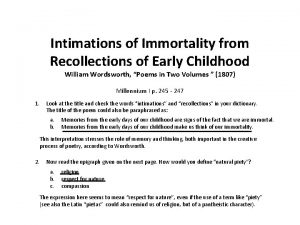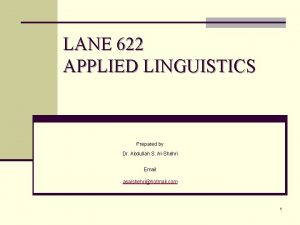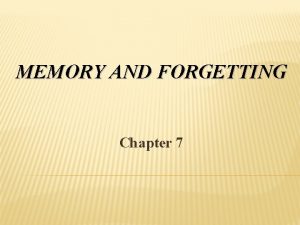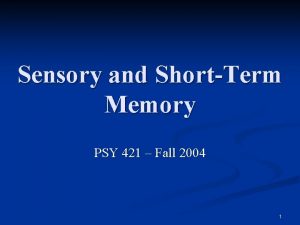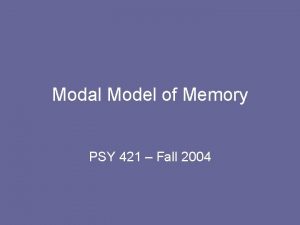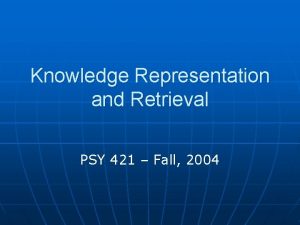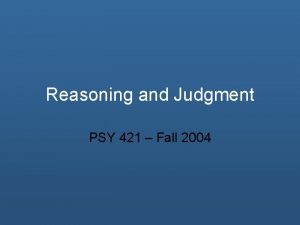Forgetting and Memory Improvement PSY 421 Fall 2004










- Slides: 10

Forgetting and Memory Improvement PSY 421 – Fall 2004 1

Overview Ø Forgetting l l l Interference Cognitive Inhibition Directed Forgetting Ø Memory Improvement l l Memory Techniques Prospective vs. Retrospective Memory 2

Forgetting Ø Exactly what is this? l l l l l Ø Attention problems Cognitive inhibition Insufficient encoding Poor performance on a memory test Response bias Mismatch between encoding and retrieval Confusion Inability to discriminate Interference Context effects Notice that none of these options is associated with a physical abnormality that results in "terrible memory ability" 3

Interference Ø Types l l Ø Proactive – information learned before the target item was learned interferes with the memory for the target item Retroactive – information learned after the target item was learned interferes with the memory for the target item List Test Inter 1 2 List ference Exp A-B A-D A-B RI Grp Ctrl A-B C-D A-B None Grp Exp A-D A-B PI Grp Experimental Method Ctrl C-D A-B None for Interference Grp 4

Interference Findings The greater number of previous trials you have had with a particular task, the lower your memory performance will be because of proactive interference – Underwood, 1957 Ø Interference occurs at retrieval – Mc. Geoch, 1932 Ø Often times, multiple possible responses are competing to be the response given at test Ø Similarity can create interference – Release from Proactive Interference – Wickens, Born, and Allen, 1963 Ø Context (environmental) can also create interference to the extent that the cues it provides activate many responses or responses similar to that you are trying to retrieve Ø 5

Cognitive Inhibition Cognitive inhibition = the control of cognitive contents or processes (Harnishfeger, 1995) Ø Thought to improve across childhood and adulthood and decline with increase age Ø Age-related improvements in the ability to ignore both external sources of distraction (e. g. , selective attention) Ø Most common type of inhibition is retrieval based = there is a loss of retrieval access to inhibited items, without a loss in the availability of those items in storage (E. L. Bjork, & Anderson, 1998). Ø 6

Directed Forgetting The directed-forgetting paradigm - developed by R. A. Bjork (1972) Ø After material has been presented for study, participants are told to remember some of it and to forget the remainder Ø The remember and forget cues can be presented either after each item (item cuing) or after a group of items (list cuing) Ø If directed forgetting is successful, then there will be Ø l l Ø (a) only a small number of intrusions of forget-cued items when participants are asked to recall only the remember-cued items (b) a poor recall of forget-cued items when participants are asked to recall items. Research results indicate that young adults are able to minimize interference from the to-be-forgotten material (Mac. Leod, 1998) and that children begin to gain control over their forgetting in the elementary school years (Golding & Long, 1998; Lehman & Bovasso, 1993; Wilson & Kipp, 1998). 7

Memory Improvement Ø What do we know so far? l l l Ø Memory improvement devices l l Ø Pay attention Elaborate, especially on meaning for what needs to be remembered Try to anticipate under what conditions you will need to remember the information and then encode it under those same or similar conditions Mnemonic techniques Method of loci (location) Peg-Word technique Keyword technique Remembering to Remember 8

Mnemonic Devices Ø Ø Ø Mnemonic = Naïve vs. Technical Naïve = memory strategies we use spontaneously – without instructions l l l Ø Acronyms with first letters Imagery Rhyming Technical = strategies not used everyday, usually need to be taught how they work l l l Method of Loci – visual imagery and spatial information Peg-Word technique – visual imagery to see "items" hung on a peg Keyword technique – associating images with words and these images interact 9

Remembering to Remember Ø Remember to feed the cat – do your homework – go to the game – read an assigned chapter – send a birthday card – remembering to do something in the future = prospective memory l l l Ø Benefit from external memory aids (writing things down) Many of the everyday memory failures are failures of prospective memory The makers of Post-it Notes – their muse? Remembering the scientist who developed Structuralism – remembering what color the slides were last lecture – remembering the last time PSU beat Purdue in football – remembering something from the past = retrospective memory 10 10

